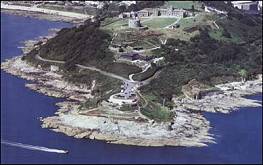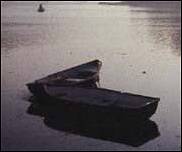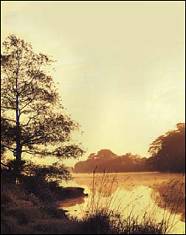Falmouth
Falmouth -Truro Estuaries and Creeks
 The name of Falmouth is inextricably linked with maritime history. Located
on the sheltered bank of one of the finest natural harbours in the world,
and at the mouth of a network of creeks and rivers, Falmouth was the port
from which the renowned Packet ships set sail to the Mediterranean and the
Americas in the seventeenth century.
The name of Falmouth is inextricably linked with maritime history. Located
on the sheltered bank of one of the finest natural harbours in the world,
and at the mouth of a network of creeks and rivers, Falmouth was the port
from which the renowned Packet ships set sail to the Mediterranean and the
Americas in the seventeenth century.
The Fal Estuary's deep water and sheltered anchorage have been of strategic importance to the defence of Britain since Tudor times. Any enemy ship securing the waters could easily land an army on the mainland. Henry VIII recognised this threat and built the sister castles of Pendennis and St Mawes on opposite sides of the Carrick Roads to protect the anchorage. Thus began one of the most fascinating stories of British coastal defence spanning 450 years. Pendennis Castle is a showpiece of British history and one of Falmouth's principal attractions.
As the premier resort of West Cornwall, Falmouth's four main beaches of Gyllyngvase, Castle, Swanpool and Maenporth are second to none. Wide expanses of sand, dipping down to the seashore offer the perfect arena for sunbathing, swimming, sandcastle building or simply forgetting the rest of the world exists!
Falmouth is a veritable waterworld. Climb aboard one of the many pleasure boats and ferries which ply the local waters to St Mawes, Flushing, Truro and the Helford Passage, and experience the maritime charm of this most beautiful part of Cornwall. For the more independent visitor, yachts can be chartered by the day from local businesses, which are happy to provide a skipper so that you can simply relax and enjoy the view. For those who like terra firma, a hop-on hop-off road train travels a continuous circular route in season linking the town, beaches and castle, or you can join a guided maritime walk led by our qualified Blue Badge Guides, just ask at the Tourist Information Centre for details.
 From
the first custom built tourist hotel in 1865 to today's imposingly futuristic
Ships and Castles Leisure Pool, the resort has invested in its future and
is rapidly developing an international reputation as one of the great sailing
and watersports centres of the world. Falmouth's International Maritime
Centre opening to the public in 2001, will house the National Maritime Museum's
small boat collection, Cornwall Maritime Museum, an events plaza and yachting
centre.
From
the first custom built tourist hotel in 1865 to today's imposingly futuristic
Ships and Castles Leisure Pool, the resort has invested in its future and
is rapidly developing an international reputation as one of the great sailing
and watersports centres of the world. Falmouth's International Maritime
Centre opening to the public in 2001, will house the National Maritime Museum's
small boat collection, Cornwall Maritime Museum, an events plaza and yachting
centre.
Falmouth's bustling town centre contains many of the expected highstreet names, alongside specialist craft shops, fresh seafood sellers, chandlers and vendors of all things nautical. Laced with many notable listed buildings such as the King's Pipe which was used to burn contraband tobacco in the days of smuggling, the town has a reassuring warmth and offers an exciting range of opportunities and watersports activities.
In Victorian times, Falmouth's world wide links across the seas, led to the development of large private gardens, later donated to the local people, containing wonderfully exotic plants. Owing to the incredibly mild climate, species such as Citrus, Daturas, Dracaena Palms, Camellias, Abutilons, Azaleas, Rhododendrons and many unusual species of Bamboo still thrive today, and at Fox Rosehill Gardens banana trees grow in the open! In addition to Falmouth's four central public gardens of Kimberley Park, Gyllyngdune, Fox Rosehill and Queen Mary, winner of the Green Flag Park Award for both 1998 and 1999, the vast gardens of Trelissick, Glendurgan and Trebah are all within easy reach.
Falmouth
-Truro
Estuaries and Creeks
 Penryn,
at the head of its own river, is the nearest town to Falmouth. Founded in
1216, Penryn was a thriving port in 1600s, handling the shipment of locally
mined tin and copper. Today, Penryn has retained an enormous amount of its
architectural heritage. Its array of Tudor, Jacobean and Georgian buildings
has established the town as an Outstanding Conservation Area, richly steeped
in history. During the summer months, Penryn celebrates this history with
the famous Lady Jane Killigrew festival including a torchlight procession,
carnival and street fair.
Penryn,
at the head of its own river, is the nearest town to Falmouth. Founded in
1216, Penryn was a thriving port in 1600s, handling the shipment of locally
mined tin and copper. Today, Penryn has retained an enormous amount of its
architectural heritage. Its array of Tudor, Jacobean and Georgian buildings
has established the town as an Outstanding Conservation Area, richly steeped
in history. During the summer months, Penryn celebrates this history with
the famous Lady Jane Killigrew festival including a torchlight procession,
carnival and street fair.
Across the Penryn River from Falmouth lies the waterside village of Flushing. Reputed to have the mildest climate in the whole of England, you can walk from here around the headland to Mylor Harbour and Churchtown, looking across the mouth of the Carrick Roads to the Roseland Peninsula. Mylor Bridge at the head of Mylor Creek, from where the stone to build Truro cathedral was shipped, is now a modern yachting harbour, catering for the needs of both local clubs and visiting sailors. The charming waterside village at the head of Restronguet Creek captures the idyllic nature of the area with whitewashed, thatched cottages with moorings at the bottom of the garden.
 Hidden
away past the turning to the King Harry Car Ferry, which connects the Truro,
side of the Fal River with the Roseland Peninsula is the village of Feock,
one of the most attractive hamlets in Cornwall. Heading up the Fal toward
Truro, you come to Tolverne, an embarkation point for American troops during
the D-Day landings. Smuggler's Cottage on the water's edge was requisitioned
by the American military during the Second World War and President Eisenhower
stayed there. It is now a popular restaurant and cream tea haunt with an extensive
collection of memorabilia from the period and a permanent display highlighting
the role the area played during the war. The creeks and rivers are best explored
by taking one of the pleasure boats or passenger ferries which ply between
Truro, Malpas, Tolverne and Falmouth during the season.
Hidden
away past the turning to the King Harry Car Ferry, which connects the Truro,
side of the Fal River with the Roseland Peninsula is the village of Feock,
one of the most attractive hamlets in Cornwall. Heading up the Fal toward
Truro, you come to Tolverne, an embarkation point for American troops during
the D-Day landings. Smuggler's Cottage on the water's edge was requisitioned
by the American military during the Second World War and President Eisenhower
stayed there. It is now a popular restaurant and cream tea haunt with an extensive
collection of memorabilia from the period and a permanent display highlighting
the role the area played during the war. The creeks and rivers are best explored
by taking one of the pleasure boats or passenger ferries which ply between
Truro, Malpas, Tolverne and Falmouth during the season.
Falmouth and South West Cornwall Guide
Cornwall
Online - Tourism and Holiday Guide
Copyright ©
1999 - Disclaimer